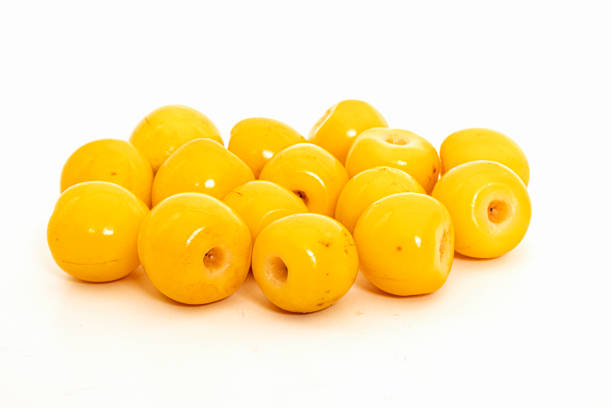Contents
1. Introduction: Discovering the Nance Fruit
Have you ever heard of the nance fruit? This small tropical fruit, scientifically known as Byrsonima crassifolia, is an intriguing and delicious addition to the diverse array of fruits found around the world. In this article, we will explore the captivating characteristics, culinary uses, and cultural significance of the nance fruit, shedding light on its growing prominence in the global market.
2. The Origin and Distribution of Nance Fruit
The nance fruit originates from the tropical regions of the Americas, particularly Central America and northern South America. It thrives in warm and humid climates, making it a common sight in countries such as Mexico, Costa Rica, Panama, Colombia, and Venezuela. The fruit grows on evergreen trees that can reach heights of up to 25 feet, adorned with glossy leaves and vibrant yellow flowers.
3. Physical Characteristics of Nance Fruit
Nance fruit is small in size, roughly the size of a cherry or a grape. It has a smooth, thin skin that varies in color from bright yellow to reddish-brown when fully ripe. The flesh of the fruit is juicy and pale yellow, encapsulating a single large seed in its center. Despite its diminutive size, the nance fruit packs a punch of tangy and tropical flavors that are reminiscent of a combination of apricot and pineapple.
4. Nutritional Value and Health Benefits
Nance fruit not only tantalizes the taste buds but also offers several nutritional benefits. It is a rich source of vitamins C and A, providing a boost to the immune system and promoting healthy skin and vision. The fruit also contains essential minerals like potassium and calcium, aiding in maintaining proper bodily functions. Furthermore, nance fruit possesses antioxidants that help combat free radicals and reduce the risk of chronic diseases.
5. Culinary Uses of Nance Fruit
In the culinary world, nance fruit finds its way into an assortment of dishes and beverages. Its unique flavor profile makes it an excellent addition to jams, jellies, and preserves. It is also used in the preparation of refreshing beverages, including juices, smoothies, and cocktails. Additionally, nance fruit can be incorporated into desserts such as pies, tarts, and ice creams, adding a tropical twist to traditional recipes.
6. Traditional and Medicinal Applications
For centuries, indigenous communities in the regions where nance fruit grows have utilized it for its medicinal properties. The fruit is believed to have anti-inflammatory and antimicrobial properties, making it beneficial for treating digestive disorders, fevers, and skin conditions. Traditional healers often incorporate nance fruit into herbal remedies and teas to harness its therapeutic potential.
7. Nance Fruit in Popular Culture
Nance fruit has also found its way into the cultural fabric of various communities. In folklore and traditional songs, the fruit is often celebrated for its vibrant color, distinctive taste, and cultural significance. It is a source of inspiration for artists, poets, and writers, symbolizing the richness and diversity of tropical landscapes. Nance fruit has become an emblem of cultural identity and pride in many regions.
8. The Growing Popularity of Nance Fruit
In recent years, the popularity of nance fruit has surged beyond its traditional growing regions. Its unique taste and versatility in culinary applications have attracted the attention of chefs, food enthusiasts, and health-conscious individuals around the world. The increasing demand for exotic fruits has driven the availability of nance fruit in international markets, making it more accessible to a wider audience.
9. Cultivation and Harvesting of Nance Fruit
Cultivating nance fruit requires specific conditions to ensure optimal growth and fruit production. The trees thrive in well-drained soil and prefer areas with abundant sunlight. They are relatively low-maintenance and can withstand periods of drought. The fruits are harvested when fully ripe, as they do not ripen further after being picked. The delicate nature of the fruit necessitates careful handling during the harvesting process.
10. Interesting Facts
- The nance fruit is known by various names in different regions, including nanche, craboo, golden spoon, and savanna serrette.
- Nance fruit is not only consumed fresh but is also dried and used as a flavoring agent in culinary creations.
- The trees that bear nance fruit are often valued for their decorative qualities and are planted as ornamentals in gardens and parks.
- In some cultures, nance fruit is associated with fertility and is used in traditional rituals and ceremonies.
- Nance fruit is highly perishable and should be consumed shortly after harvest to fully enjoy its flavors and benefits.
11. The Future Potential of Nance Fruit
As the world becomes more interconnected, the demand for unique and exotic fruits continues to grow. Nance fruit, with its enticing flavor and nutritional value, has the potential to become a sought-after commodity in international markets. With advancements in transportation and global trade, consumers from all corners of the globe can savor the delights of this tropical gem. The rising popularity of nance fruit offers promising opportunities for farmers, entrepreneurs, and consumers alike.
12. Conclusion
In conclusion, the nance fruit is a tropical delight that captivates with its tangy flavor, vibrant color, and numerous health benefits. From its humble origins in the tropical regions of the Americas to its expanding popularity on the global stage, this small fruit has carved a place for itself in culinary creations, traditional practices, and cultural symbolism. As we continue to explore the diverse world of fruits, let us not overlook the alluring appeal of the nance fruit.
FAQs
Is nance fruit easy to find in local grocery stores?
While nance fruit is more commonly found in regions where it is cultivated, it may be challenging to find in local grocery stores outside of its native growing areas. However, specialty stores and online markets may offer nance fruit or products derived from it.
Can nance fruit be grown in home gardens?
Yes, it can be grown in suitable climates and with proper care. If you live in a tropical or subtropical region and have the necessary conditions, you can consider cultivating nance fruit trees in your home garden.
Does nance fruit have any side effects?
Nance fruit is generally safe to consume. However, like any food, it may cause allergic reactions in some individuals. If you have any concerns or known allergies, it is advisable to consult a healthcare professional before incorporating nance fruit into your diet.
Where can I find nance fruit products online?
There are several online platforms that offer nance fruit products, including dried nance fruit, preserves, and juices. Conduct a search for reputable online retailers or specialty food websites to explore the available options.


